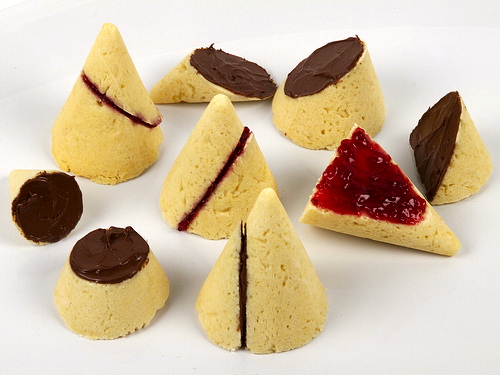From several sources on the net, this entertaining story posted 6/25/13 on the Evil Mad Scientist site:
Play with your food: How to Make Sconic Sections
The conic sections are the four classic geometric curves that can occur at the intersection between a cone and a plane: the circle, ellipse, parabola, and hyperbola.
The scone is a classic single-serving quick bread that is often served with breakfast or tea.
And, at the intersection of the two, we present something entirely new, delightfully educational, and remarkably tasty: Sconic Sections.
Detailed instructions follow. The edges of the sections can be highlighted by jam, chocolate, or Nutella (as above).
Sconic sections is a nice portmanteau of scone and conic sections — an excellent term for things that are both scones and conic sections.
Now, about scones, from Wikipedia:
A scone is a single-serving cake or quick bread. They are usually made of wheat, barley or oatmeal, with baking powder as a leavening agent, and are baked on sheet pans. They are often lightly sweetened and are occasionally glazed. The scone is a basic component of the cream tea or Devonshire tea. It differs from a tea cake and other sweet buns, which are made with yeast
On the pronunciation of scone, again from Wikipedia:
The pronunciation of the word within the United Kingdom varies. According to one academic study, two-thirds of the British population pronounce it /ˈskɒn/ with the preference rising to 99% in the Scottish population. This is also the pronunciation of Australians, Canadians and New Zealanders. Other regions, particularly the United States and Ireland, pronounce the word as /ˈskoʊn/. The pronunciation /ˈskʊn/ is also used, particularly in Ireland. British dictionaries usually show the “con” form as the preferred pronunciation, while recognising that the “cone” form also exists.
The difference in pronunciation is alluded to in the poem which contains the lines:
I asked the maid in dulcet tone
To order me a buttered scone
The silly girl has been and gone
And ordered me a buttered scone.The Oxford English Dictionary reports that the first mention of the word was in 1513. Origin of the word scone is obscure and may, in fact, derive from different sources.
That’s three pronunciations for the word (four, if ɔ – a variation is taken into account). Then there’s the pronunciation of the proper name Scone – /ˈskuːn/ — which is still another. On the place and the Stone of Scone:
Scone … is a village in Perth and Kinross, Scotland. The medieval village of Scone, which grew up around the monastery and royal residence, was abandoned in the early 19th century when the residents were removed and a new palace was built on the site by the Earl of Mansfield. Hence the modern village of Scone, and the medieval village of Old Scone, can often be distinguished. (link)
The Stone of Scone …, also known as the Stone of Destiny and often referred to in England as The Coronation Stone, is an oblong block of red sandstone, used for centuries in the coronation of the monarchs of Scotland and later the monarchs of England, Great Britain, and the United Kingdom. Historically, the artifact was kept at the now-ruined Scone Abbey in Scone, near Perth, Scotland. (link)

